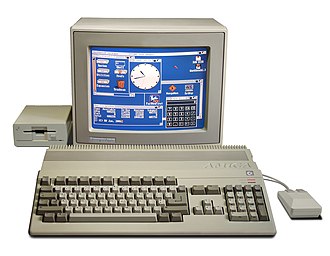Amiga







Amiga
The Amiga is a family of personal computers originally developed by Amiga Corporation and later marketed and sold by Commodore International in the 1980s and 1990s. The first model, the Amiga 1000, was released in 1985 and was notable for its advanced graphics and sound capabilities, which were ahead of its time.
History[edit]
The development of the Amiga began in 1982 with the formation of Amiga Corporation by Jay Miner and a group of other engineers. The company initially focused on creating a new gaming console, but the project evolved into a full-fledged personal computer. In 1984, Amiga Corporation was acquired by Commodore International, which provided the necessary funding to complete the project.
The Amiga 1000 was launched in July 1985 and was followed by several other models, including the Amiga 500, Amiga 2000, Amiga 3000, and Amiga 4000. Each new model introduced improvements in performance, graphics, and sound.
Technical Specifications[edit]
The Amiga computers were based on the Motorola 68000 series of microprocessors. They featured a custom chipset that included the Agnus, Denise, and Paula chips, which handled graphics, video, and audio processing, respectively.
Graphics[edit]
The Amiga's graphics capabilities were one of its most significant selling points. It supported multiple display modes, including HAM (Hold-And-Modify) mode, which allowed for up to 4096 colors on screen simultaneously. The system also supported hardware sprites and a blitter for fast graphics operations.
Sound[edit]
The Amiga's sound capabilities were equally impressive, featuring four-channel stereo sound with a sample rate of up to 28 kHz. The Paula chip was responsible for audio processing and could handle complex sound effects and music.
Operating System[edit]
The Amiga ran on the AmigaOS, which was a multitasking operating system with a graphical user interface. The OS was known for its efficiency and responsiveness, even on the relatively modest hardware of the time.
Legacy[edit]
The Amiga was highly influential in the development of multimedia computing and had a significant impact on the demoscene, a subculture focused on creating audio-visual presentations. Despite its initial success, the Amiga platform struggled in the face of increasing competition from IBM PC compatible systems and Apple Macintosh computers.
After Commodore declared bankruptcy in 1994, the Amiga brand changed hands several times. Various companies attempted to revive the platform, but none achieved significant commercial success.
Related Pages[edit]
Categories[edit]
Ad. Transform your life with W8MD's Budget GLP-1 injections from $75


W8MD offers a medical weight loss program to lose weight in Philadelphia. Our physician-supervised medical weight loss provides:
- Weight loss injections in NYC (generic and brand names):
- Zepbound / Mounjaro, Wegovy / Ozempic, Saxenda
- Most insurances accepted or discounted self-pay rates. We will obtain insurance prior authorizations if needed.
- Generic GLP1 weight loss injections from $75 for the starting dose.
- Also offer prescription weight loss medications including Phentermine, Qsymia, Diethylpropion, Contrave etc.
NYC weight loss doctor appointmentsNYC weight loss doctor appointments
Start your NYC weight loss journey today at our NYC medical weight loss and Philadelphia medical weight loss clinics.
- Call 718-946-5500 to lose weight in NYC or for medical weight loss in Philadelphia 215-676-2334.
- Tags:NYC medical weight loss, Philadelphia lose weight Zepbound NYC, Budget GLP1 weight loss injections, Wegovy Philadelphia, Wegovy NYC, Philadelphia medical weight loss, Brookly weight loss and Wegovy NYC
|
WikiMD's Wellness Encyclopedia |
| Let Food Be Thy Medicine Medicine Thy Food - Hippocrates |
Medical Disclaimer: WikiMD is not a substitute for professional medical advice. The information on WikiMD is provided as an information resource only, may be incorrect, outdated or misleading, and is not to be used or relied on for any diagnostic or treatment purposes. Please consult your health care provider before making any healthcare decisions or for guidance about a specific medical condition. WikiMD expressly disclaims responsibility, and shall have no liability, for any damages, loss, injury, or liability whatsoever suffered as a result of your reliance on the information contained in this site. By visiting this site you agree to the foregoing terms and conditions, which may from time to time be changed or supplemented by WikiMD. If you do not agree to the foregoing terms and conditions, you should not enter or use this site. See full disclaimer.
Credits:Most images are courtesy of Wikimedia commons, and templates, categories Wikipedia, licensed under CC BY SA or similar.
Translate this page: - East Asian
中文,
日本,
한국어,
South Asian
हिन्दी,
தமிழ்,
తెలుగు,
Urdu,
ಕನ್ನಡ,
Southeast Asian
Indonesian,
Vietnamese,
Thai,
မြန်မာဘာသာ,
বাংলা
European
español,
Deutsch,
français,
Greek,
português do Brasil,
polski,
română,
русский,
Nederlands,
norsk,
svenska,
suomi,
Italian
Middle Eastern & African
عربى,
Turkish,
Persian,
Hebrew,
Afrikaans,
isiZulu,
Kiswahili,
Other
Bulgarian,
Hungarian,
Czech,
Swedish,
മലയാളം,
मराठी,
ਪੰਜਾਬੀ,
ગુજરાતી,
Portuguese,
Ukrainian
